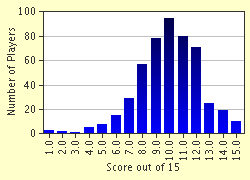Quiz Answer Key and Fun Facts
1. Occurring on May 22, 1960, in which country was the most powerful earthquake ever recorded up to that time?
2. There are three types of rocks. Into which category does limestone fall?
3. How quickly do tectonic plates move?
4. Who proposed the theory of Continental Drift?
5. Earthquakes happen somewhere on Earth every 11 seconds.
6. Sometimes, space debris makes it through the atmosphere and hits Earth. Where is the world's largest impact crater?
7. What is immediately below the crust?
8. How thick is the ocean's crust?
9. Uluru is Earth's largest rock?
10. How many major tectonic plates are there?
11. In which ocean would you find the "Ring of Fire?"
12. Once, in China, an earthquake killed about 830,000 people?
13. Frederick Mohs created the Mohs' Scale. This scale ranges from 1-10 and tells you the hardness of a mineral. What is the hardest mineral in any scale?
14. How old is Earth?
15. The moon has tectonic plates.
Source: Author
uradenejkine
This quiz was reviewed by FunTrivia editor
minch before going online.
Any errors found in FunTrivia content are routinely corrected through our feedback system.

